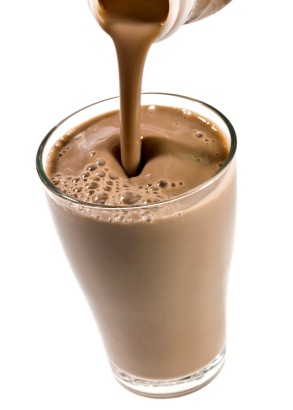

Performance Enhancing Supplements:
Part 3, Chocolate Milk
By certified sports nutritionist Marcia Homer, MS, CSN
Back to list of our training, coaching and nutrition essays

Les Woodland's book The Olympics' 50 Craziest Stories: A Five Ring Circus is available as an audiobook here. For the print or Kindle eBook versions, just click on the Amazon link on the right.
Marcia Homer writes:
When I crossed the finish line of the Las Vegas Marathon in 1997 and was handed a cold bottle of chocolate milk, I thought it was weird.
So, I’ve always had a curiosity around chocolate milk as a post-exercise recovery drink and have grabbed a cold bottle after a long run over the years.
Since then, chocolate milk has been researched as a potential recovery beverage and the results are quite favorable.

Read on for more about the science of humble chocolate milk
We know that the body can better handle carbohydrates during and after physical activity. Consuming carbohydrates and protein during the post-workout period enables the athlete to replace muscle glycogen and improve recovery. Like a sponge, an athlete draws in glycogen much more readily immediately after training, for up to about three hours.
That window of glycogen consumption/replacement depends on many factors such as intensity of exercise, body composition, underlying health conditions, sleep schedule, length and type of exercise and what time of day it is (Josephson, 2006). Chocolate milk contains carbohydrate and protein in similar amounts to various sports beverages associated with improved post-exercise recovery. In addition, chocolate milk has been noted for its good taste, wide availability, low cost and convenience, which could make it a popular alternative to commercial sports beverages.
The Science
An ideal recovery beverage will have between a 3:1 and 4:1 carbohydrate to protein ratio. The carbohydrate should be an adequate amount to refill glycogen stores and should enter the bloodstream quickly for optimal storage. The protein should contain many, if not all, of the essential amino acids necessary to stop muscle breakdown and begin muscle repair. Finally, the beverage should adequately replace the fluids and electrolytes lost during exercise while being acceptable in taste and digestion.
The liquid assets of chocolate milk are numerous. Low-fat chocolate milk has nine essential nutrients, including some not typically found in recovery drinks. These include: B vitamins for energy, and the combination of five bone-building nutrients including calcium, vitamin D, phosphorus, protein and potassium —to help athletes build and maintain strong bones and reduce risk for stress fractures.
Chocolate milk is a “natural” when it comes to electrolytes. In fact, chocolate milk naturally provides some of the same electrolytes that are added to commercial recovery drinks—including calcium, potassium, sodium and magnesium. Drinking chocolate milk after exercise can help replace essential electrolytes—including potassium, sodium, magnesium, and calcium—that are lost in sweat (Cockburn et al., 2008).
Pritchett et al (2009) conducted a study in which ten regional-level cyclists and triathletes completed a high-intensity exercise. Fifteen–eighteen hours later, they also conducted a performance trial at 85% of maximal oxygen uptake—to exhaustion. After the first bout of high-intensity exercise, the participants consumed a commercial recovery drink or chocolate milk (randomly assigned).
The same process was followed a week later—with the athlete consuming whichever beverage they didn’t drink before. Although creatine kinase levels were higher with the commercial recovery drink, the findings did not indicate any difference between the two beverages as potential post work-out recovery aids.
We know that glycogen, which is stored in the muscles, is the fuel source athletes must restore following strenuous training. Muscle glycogen is the predominant fuel source used during bouts of aerobic exercise. In fact, aerobic performance is directly related to initial glycogen stores. Once glycogen is depleted, the athlete will feel fatigued and performance will suffer.
Chocolate milk has a 3:1 ratio of carbohydrate grams to protein grams, which appears to enhance glycogen replenishment into the muscles post workout. Chocolate milk also contains whey protein, which is digested and absorbed quickly, getting essential amino acids circulating in the blood stream soon after consumption. Whey protein has been attributed to enhancing the building and repair of muscle. Chocolate milk also contains the protein casein, which is digested and absorbed more slowly than whey protein and sustains amino acids in the circulation many hours after consumption. Casein is thought to reduce the amount of muscle breakdown (Millard-Stafford et al., 2005).
Similarly, Cockburn et al 2008 reported that compared to carbohydrate beverages, chocolate milk ingestion during recovery from heavy eccentric exercise improved peak torque and total work during subsequent exercise. It should be noted, however, that the carbohydrate beverages utilized in this study contained fewer calories than chocolate milk, so it is possible that the purported benefits may have been related to caloric differences between treatments.
Considerations
There are some considerations when choosing chocolate milk as a post-exercise recovery drink. It does have a short shelf life (it is prone to spoiling and needs to be kept cold). It is also not as portable as powders are for storage and later use. Also, some athletes report difficulties in digesting milk and milk products. It should be noted that flavored soymilk is an equally effective product, but tends to cost a little more than cow’s milk.
Bottom Line
Increasingly, many fitness experts consider chocolate milk an effective option as a post-exercise recovery drink. It aids in building muscle, replenishing muscle “fuel” (glycogen) after exercise, and replenishing electrolytes lost in sweat including potassium, calcium and magnesium. Chocolate milk happens to have an ideal nutritional profile with the right mix of carbs and high-quality protein (not to mention its affordability and great taste). Recent studies (noted above) have also shown that athletes who consume chocolate milk post-workout had improved training times and better body composition. So grab a bottle of chocolate milk next time you finish a long run or a hard-core cycling routine. It can aid your recovery, helps reduce the chances of injury, and boost the health and well-being of an athletic body.
Marcia holds a Master of Applied Exercise Science degree from Concordia University, Chicago. She is also an ACE certified Health Coach as well as a Certified Sports Nutritionist through the International Society of Sports Nutrition. As a marathon runnerX45, Hood-to-Coast captain, Ironman triathlete, Tough Mudder and Crossfit Masters competitor, Marcia knows first-hand the importance of proper nutrition in endurance sports
References
Cockburn E., Hayes P., French D. (2008). Acute milk-based protein-CHO supplementation attenuates exercise-induced muscle damage. Applied Physiology, Nutrition, and Metabolism, 33, 775-83.
Josephson, MS, S. (2006). Recovery Nutrition. NSCA's Performance Training Journal, 2(5), 1-2.
Millard-Stafford, M., Childers, W., Conger, S., Kampfer, A., & Rahnert, J. (2008). Recovery Nutrition: Timing and Composition after Endurance Exercise. Current Sports Medicine Reports, 7(4), 193-201.
Millard-Stafford, M., Warren, G., Thomas, L., Doyle, J., Snow, T., & Hitchcock, K. (2005). Recovery from Run Training: Efficacy of a Carbohydrate-Protein Beverage? International Journal of Sport Nutrition and Exercise Metabolism, 15, 610-624.
Pritchett, K., Bishop, P., Pritchett, R., Green, M., & Katica, C. (2009). Acute effects of chocolate milk and a commercial recovery beverage on post-exercise recovery indices and endurance cycling performance. Applied Physiology, Nutrition and Metabolism, 34(6), 1017-22.








